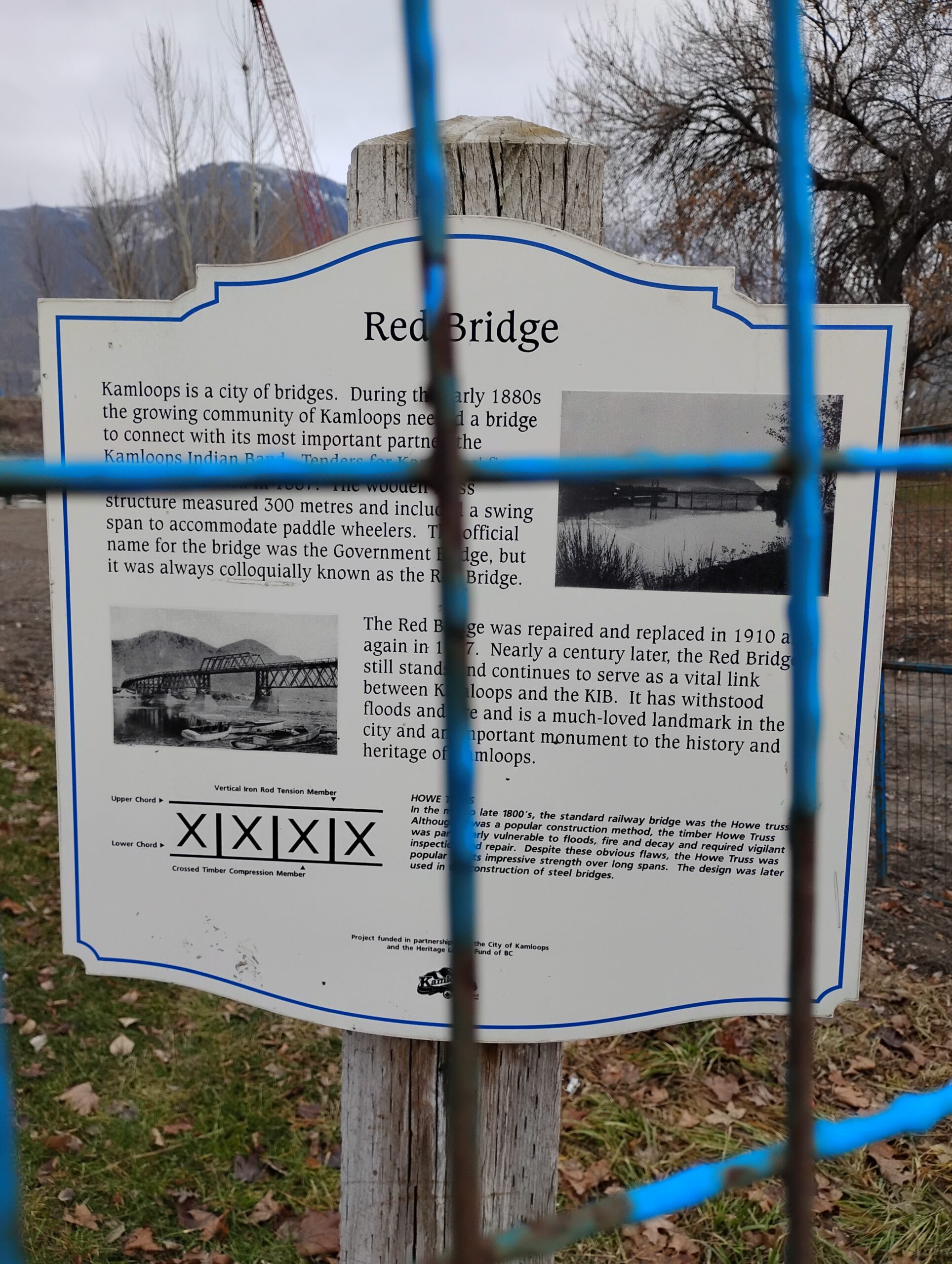Now, it is a big empty space. A long chain link black fence surrounds part of the Rivers Trail and Pioneer Park walking path.
Instead of dogs and people there now stand cranes and vehicles and workers. People still go for a walk via the Rivers Trail. They walk their dogs. They walk in groups or pairs. They run. They bike. Still doing things they did before. Before the fire.
And that is a good thing.
While I have read the heritage sign posted on the trail, I stopped to read it one more time. How long would the sign remain? The Red Bridge no longer stands. That got me thinking, how much history did I know of the Red Bridge?
Luckily, I found a lecture concerning the Red Bridge given by Colleen Stainton, who has examined the history surrounding the bridge via her work with the Lorne St. Entrance Project for the Communities in Bloom Bicentennial Committee in 2012.
Before the bridge, a fur trading post was built in 1812. The indigenous people were traders with others in the territory and crossed the river by using a ferry system consisting of a rowboat and barge. Wagons and goods were loaded onto a barge and horses swam alongside. The crossing could be dangerous; especially during flooding or when ice was forming or breaking up.
By the 1880s people understood the need for a bridge to connect the town, the TK’emlups Reserve, and the ranches in the North Thompson district. It was not until the Canadian Pacific Railway divisional headquarters came to the city in 1887 and gave status to the need for a bridge. This allowed George P. Vernon, Chief Commissioner of Lands and Works, enough support to acquire funding for a bridge to be built.
Hli-hleh-Kan; Chief Louis, guided his people in “adjusting to the settlement of a white population,” said Stainton.
The bridge was built by Dan Adams from Victoria. He used the Howe straining wooden beam trusses and suspension stay road. The bridge was finished in two months. “It was 100 feet long with a main span of 120 feet and a 50-foot swing span to allow paddlewheel steamers to travel between Kamloops and the Shuswap Lakes.”
The bridge was named Government Bridge; but the locals referred to it as the Red Bridge due to the red Douglas Fir trees used to build the bridge. The bridge was an important link between the TK’emlups Band, Kamloops merchants and ranchers.
The flood of 1894 tested the bridge. Arthur Stevenson led volunteers who hauled rocks onto the bridge at both ends which held the decking down. The bridge may have swayed, but it remained intact. However, bridges downstream were not so lucky.
By 1910 the bridge needed to be replaced so in 1912 a new bridge was completed. This time with a higher clearance to accommodate the larger paddle-wheelers that were now sailing downriver.
The south side of the bridge was burned and condemned in 1931. The Government planned to build another bridge as it was an important transportation connection. Therefore, the second Red Bridge was built in 1932 and continued operation until replaced.
The third Red Bridge was built in 1936. Built in five months the foreman Paul McMasters said the bridge, “should be good for more than 30 years.” However, in 1968 the bridge faced demolition due to the Yellowhead Bridge construction. Mayor Peter Wing pointed out that the bridge was a necessary link to Reserve land and its expanding industrial area, and the Government was convinced to carry out repairs, said Stainton.
Nineteen-seventy found the bridge closed for three months for reconstruction work which extended its life and at this time the walkway railing was painted red at the suggestion of the Downtown Business Association.
Two thousand four found the bridge closed for three weeks while steel piers were driven into the riverbed. These improvements along with the repair of the superstructure prolonged the life of the bridge by 20 years; explained Stainton.
Then, 2024; the bridge burned down.
Premier David Eby and MLA Petrer Milobar have said the bridge would be replaced. I, for one, see a gaping emptiness. I hope the history of people, buggies and cattle driven across the bridge will be remembered as an important part of Kamloops transportation history.
NOTE: “William Howe Truss designed and patented the Howe truss in 1840. The design consisted of crossed timbers in a “X” pattern, similar to Stephen Long’s truss except Howe replaced the upright vertical timbers with metal rods which could be adjusted by tightening the nuts or turnbuckles thus retaining the strength of the truss during and after construction. He was also the first to use metal components as primary members. His method made it possible for bridges to withstand heavy loads used by railways. However, his bridge was expensive to build, and it ended the need for the Long Truss.” (Google)
Submitted by June Corcoran

